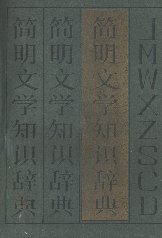简明文学知识辞典
西北师范学院中文系文艺理论教研室编,甘肃人民出版社1985年出版。32开,634页。收录条目约1500条。内容包括:文学理论、作家、文艺理论家、中外作品、历代论文和文学人物等。
简明文学知识辞典
张学仁主编,未来出版社1992年2月出版。32开,390页。
简明文学知识辞典
西北师范学院中文系文艺理论教研室编。甘肃人民出版社1985年10月出版。收词1500余条,内容包括文学理论词语解释,中外作品简介,中外作家、名人简介,中国历代文论译注,文学人物介绍等5方面。词目分类编排。书末附“汉语拼音索引”。
简明文学知识辞典
张学仁主编。未来出版社1992年2月出版。

主要责任者: 西北师范学院中文系文艺理论教研室
责任方式: 编
出版者: 甘肃人民出版社
出版地: 兰州
字数: 646 千字
页码: 1-634
开本: 32
装帧: 简
语种:中
定价:3.80
出版时间:1985-10
丛书多卷书否:否
书目简介:本册工具书共收录1501条词条。